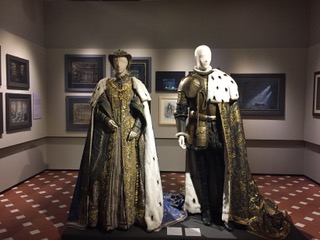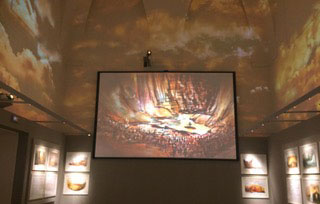
By Nona Debenham (Istituto Lorenzo de’ Medici)
Recently opened on September 1, 2017, the Franco Zeffirelli International Center for the Performing Arts gives visitors the chance to look into the life’s work of revered opera and film director Franco Zeffirelli. The Centre distinguishes itself as an unprecedented experience where people can observe and trace, through its permanent collection, exhibitions, events, classes and education courses, the birth and development of all the arts that blend together in a theatrical or cinematic production.
The center contains a permanent collection as well a space for temporary exhibitions. Located in the late 17th-century San Firenze Complex, which was originally the oratory of the Padri Filippini and more recently, the city courthouse; it is a short distance from the historic Palazzo Vecchio. The center offers access to not only thousands of books on art, history, and music but also courses on stage design as well as regular concerts and theatrical performances in its auditorium.
The museum at the Franco Zeffirelli International Centre for the Performing Arts, located on the first floor of the building, displays over 300 sketches, set design models, costumes and set photos that Franco Zeffirelli designed and collected since the beginning of his career. The rooms of the museum, in addition to holding the permanent collection of Zeffirelli’s works, will also host temporary exhibitions that relate to Zeffirelli’s career. Upon entering the center the visitor is greeted with grand staircase and one of Zeffirelli’s costumes as the centerpiece. As one ascends the staircase towards the museum entrance, music from the score of his movies is playing in the corridor setting the tone for the visitor experience. However, the actual entrance to the museum is further down the hallway and around the corner. It is only marked with a small sign, leaving the visitor unsure of the entry into the museum.
The setup of the Museum’s rooms is divided chronologically into three general categories, theater, opera, and cinema. The planned itinerary of the museum is well thought-out and guides the visitor along the career and artistic developments of Franco Zeffirelli. While there are signs indicating the path, it is easy to miss them and thus lose the didactic experience the curators intended. Each section illustrates the developments in Zeffirelli’s career and is complemented with set photos, costumes, and documents or 3-D models. Visitors to the museum are able to see the paintings and sketches that laid the groundwork for many of his productions, such as Don Giovanni and Carmen. Also featured are the costumes worn by figures such as Joan Sutherland, Gianni Raimondi, and Luciano Pavarotti. The museum uses audiovisual aids to complement the material. Allowing the visitor to really see into the creative process of Zeffirelli.
Due to the nature of the material, it is understandable why the museum uses technology to engage the visitor; however, there is lack of supporting material and the length of the audiovisual aids that detract from the museum experience. For example, in the center of the museum route is a room with a large projection screen and seating. In this space a video is played, on a loop, showing clips from Zeffirelli’s movies, operas, and theatrical productions. While the video is informative, it is extremely long, from start to finish the film lasts approximately 45 minutes. This is too long to expect a visitor to stay and watch in completion. It would be better executed to have shorter projections in each of the three sections of the museum instead of a long one in the middle. It can be overwhelming for the visitor. This is not the only instance where video projections are used in the museum. For example, in the Inferno room, there is another large projection, set to music, recreating the sketches that were inspired by Dante’s Divine Comedy, including projections of clouds onto the ceiling of the room. While the virtual projections are impressive, there is no explanatory text, or even subtitles, in any language, to accompanying the video projections. While there are labels throughout the museum they are inconsistent in the translation, as some are in both Italian and English and others are only in Italian. With improved labels and the addition of wall text the comprehension of the material could be greatly enhanced.
Overall a visitor who is unfamiliar with the works of Zeffirelli can leave the museum with a better understanding of his contribution to the theater and film industry. The museum, archive, and library, in their respective rooms, together with studios and classrooms dedicated to educational activities, the concert hall and the bar and restaurant make it a stimulating place for enthusiasts and scholars to meet, as well as encouraging interest among new generations of visitors.
For information on ticket prices, opening hours and more general information please click here.

Traduzione di Costanza Peruzzi (Università degli Studi di Firenze)
Aperto al pubblico il primo settembre 2017, il Centro Internazionale per le Arti dello Spettacolo “Franco Zeffirelli” offre ai suoi visitatori l’opportunità di sbirciare nel lavoro di una vita dello stimato regista di cinema e teatro.
Il Centro si contraddistingue come una realtà senza precedenti, dove è possibile osservare e seguire, attraverso una collezione permanente, mostre, eventi, laboratori e corsi accademici, la nascita e lo sviluppo di tutte le arti che convivono e confluiscono insieme nella produzione teatrale o cinimatografica.
Il Centro, ospitato nel secentesco Complesso di San Firenze, in origine Oratorio dei Padri Filippini e in tempi più recenti Palazzo di Giustizia della città, a breve distanza da Palazzo Vecchio, non solo dà l’opportunità di accedere a migliaia di testi di arte, storia e musica, ma offre anche veri e propri corsi di studio che contemplano tutte le discipline del mondo del teatro e del cinema (scenografia, costume, musica, regia, recitazione e scenografia), nonchè un ricco calendario di spettacoli teatrali e concerti nel suo auditorium.
Il Museo del Centro Internazionale per le Arti dello Spettacolo, situato al primo piano dello stabile, propone più di trecento schizzi, tra modelli di scenografie, costumi e set fotografici, che Franco Zeffirelli progettò e collezionò sin dall’inizio della sua carriera.
Gli spazi del museo, organizzati per ospitare la collezione permanente del lavoro di Zeffirelli, sono predisposti in modo tale da poter ospitare anche mostre temporanee, sempre relative alla sua carriera.
Entrando, il visitatore è accolto da una grande scalinata, dove uno dei costumi di Zeffirelli è posto a mo’ di colonna. Le scale che conducono al museo sono inondate dalle musiche dei suoi film che scandiscono il ritmo della visita.
Purtroppo l’entrata vera e propria del Museo rimane più in basso rispetto all’ingresso principale del Centro e nascosta dietro un angolo, indicata soltanto da una piccola insegna, e di lascia piuttosto spiazzato il visitatore intento ad accedervi.
L’allestimento delle sale è diviso cronologicamente intorno alle tre grandi categorie delle arti performative: teatro, opera e cinema. L’itinerario della visita è pensato per guidare il visitatore lungo la carriera e gli sviluppi artistici di Franco Zeffirelli, ma anche se presente, la segnalitica che indica il percorso, non è facile da seguire, e si rischia così di perdere l’intento educativo ambito dai curatori.
Ogni sezione illustra gli sviluppi della sua carriera, documentata attraverso foto, costumi, testi e modellini in 3-D. I visitatori hanno modo di vedere e scoprire disegni e bozzetti che furono alle origini di molte sue produzioni, come il Don Giovanni e la Carmen. Protagonisti di questi ambienti sono senza dubbio i costumi di scena indossati da attori quali Joan Sutherland, Gianni Raimondi e Luciano Pavarotti.
Il visitatore riesce a scrutare il vero processo creativo del maestro grazie all’utilizzo che il museo fa dei supporti audiovisivi. Per la natura stessa del matriale che qui si indaga, è comprensibile il motivo che ha spinto la direzione ad utilizzare la tecnologia per coinvolgere i visitatori. Ad ogni modo c’è una discrepanza tra i materiali di supporto e la lunghezza degli audiovisivi che nuoce all’esperienza museale: al centro del percorso di visita c’è una sala con un grande schermo e sedute dove viene riprodotto ripetutamente un video con spezzoni di film, opere e produzioni teatrali. Il video è fonte di preziose informazioni, ma è estremamente lungo, dall’inizio alla fine dura circa 45 minuti. Troppo lungo per espettarsi che i visitatori siano disposti a guardarlo per intero. Sarebbero da preferire brevi proiezioni, magari in ognuna delle tre sezioni del museo, piuttosto che un’unica lunga proiezione nel bel mezzo del percorso. Potrebbe essere più coinvolgente per chi visita.
Questa non è l’unica situazione in cui vengono proiettati filmati, per esempio nella sala Inferno, c’è un’altra lunga proiezione con base musicale che riproduce gli schizzi ispirati alla Divina Commedia di Dante,con nuvole proiettate sul tetto della stanza. Pur essendo molto suggestive, queste proiezioni virtuali mancano totalmente di testi esplicativi o sottotitoli, in qualsiasi lingua, e questo ne ostacola l’interpretazione. Al suo interno il museo è dotato di didascalie ma le traduzioni sono incoerenti, alcune sono in doppia lingua italiano-inglese, altre solo in italiano. Con un miglioramento dei cartellini e l’aggiunta di testi alle pareti, la comprensione del materiale risulterebbe senz’altro rafforzata.
Anche un visitatore che non abbia familiarità col lavoro di Zaffirelli potrà lasciare il museo con una migliore consapevolezza del suo contributo all’industria cinematografica e teatrale.
Il museo, l’archivio e la biblioteca, nelle loro rispettive stanze, insieme alle stanze utilizzate per le attività educative, la sala concerti, il bar e il ristorante, fanno del Centro un ambiente di incontro stimolante per gli ammiratori in visita e gli studenti, e stimolano l’interesse dei neofiti.
Per informazioni sul prezzo d’ingresso, gli orari di apertura, eventi e attività in programma visitate la pagina della fondazione a questo link.
(photo courtesy of Nona Debenham)